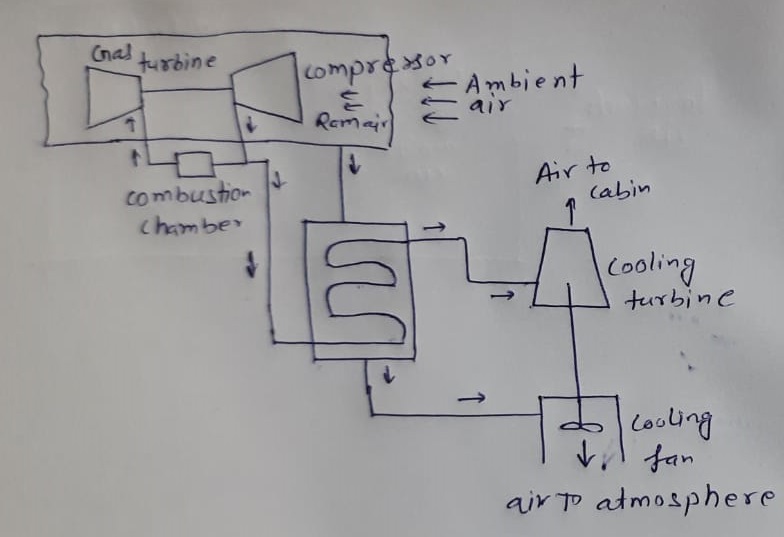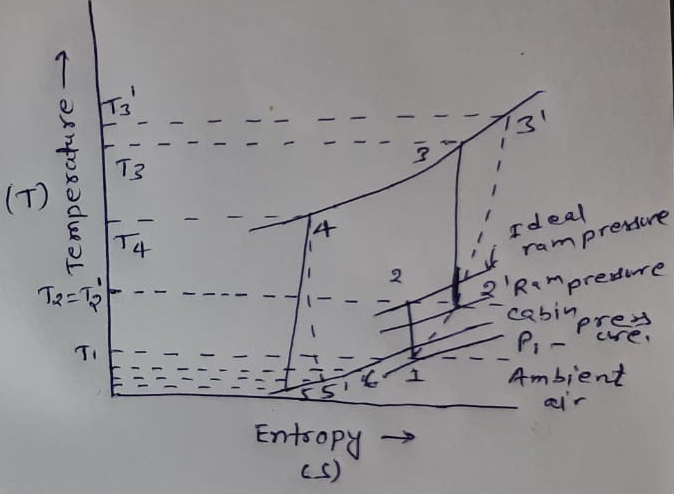In this article, you will learn about simple aircraft refrigeration system- working principle, diagram, important facts & MCQ’s with solution, in the last article I talk about different types of refrigeration system.
Working Principle of Simple Aircraft Refrigeration System-
Air needed for refrigeration system is coming from compressor. Air is first cooled with high temperature and pressure at heat exchanger and ram air is used for cooling process then air is again cooled by cooling turbine through expansion process and cooling fan draw air from heat exchanger.
Diagram of Simple Aircraft Refrigeration System-

TS Diagram of Simple Air Refrigeration System-

Main Components-
- Compressor
- Gas Turbine
- Heat Exchanger
- Cooling Turbine
- Combustion Chamber
- Cooling Air Fan
Few Amazing Facts About Simple Aircraft Refrigeration System-
- Simple aircraft refrigeration system cools passenger cabin & cargo hold during flight.
- All components of this system are compressor, condenser, expansion valve, and evaporator.
- Compressor pressurizes refrigerant vapour, raising its temperature.
- Condenser transfers heat to the ambient air, condensation happen.
- Expansion valve allows refrigerant to expand and reduce pressure before refrigerant entering evaporator.
- Evaporator absorbs heat from surrounding air, cooling the passenger cabin and cargo hold.
- Common refrigerant used is air.
- Efficiency depend on type of refrigerant choice and ambient(surrounding) temperature.
- It is essential for passenger comfort and preserving perishable cargo.
Simple Aircraft Refrigeration System MCQ’s with Solution-
1. Which component in a simple aircraft refrigeration system is responsible for compressing the refrigerant?
a) Evaporator
b) Condenser
c) Compressor
d) Expansion valve
Solution: c) Compressor
Explanation: The compressor in a simple aircraft refrigeration system is responsible for compressing the low-pressure refrigerant vapor to a high-pressure, high-temperature state, enabling it to release heat during the condensation process.
2. The primary purpose of an aircraft refrigeration system is to:
a) Generate electricity for the aircraft
b) Provide heating to the cabin
c) Cool the aircraft’s cabin and cargo hold
d) Assist with navigation
Solution: c) Cool the aircraft’s cabin and cargo hold
Explanation: The main function of an aircraft refrigeration system is to cool the aircraft’s cabin and cargo hold, ensuring a comfortable and safe environment for passengers and preserving perishable cargo.
3. Which type of refrigerant is commonly used in simple aircraft refrigeration systems?
a) R-22
b) R-134a
c) R-410A
d) R-717 (Ammonia)
Solution: b) R-134a
Explanation: R-134a is a common refrigerant used in simple aircraft refrigeration systems due to its non-toxic, non-flammable, and environmentally friendly properties.
4. The component responsible for removing heat from the refrigerant in a simple aircraft refrigeration system is the:
a) Evaporator
b) Condenser
c) Compressor
d) Expansion valve
Solution: b) Condenser
Explanation: The condenser is responsible for removing heat from the high-pressure refrigerant vapor and converting it into a high-pressure liquid through heat exchange with the surrounding air.
5. Which process in a simple aircraft refrigeration system is responsible for converting the high-pressure, high-temperature refrigerant vapor to a high-pressure liquid?
a) Evaporation
b) Condensation
c) Compression
d) Expansion
Solution: b) Condensation
Explanation: During the condensation process, the high-pressure, high-temperature refrigerant vapor loses heat and transforms into a high-pressure liquid, ready for further expansion and cooling.
6. In a simple aircraft refrigeration system, the expansion valve is responsible for:
a) Compressing the refrigerant
b) Removing heat from the refrigerant
c) Expanding the refrigerant and reducing its pressure
d) Controlling the direction of the refrigerant flow
Solution: c) Expanding the refrigerant and reducing its pressure
Explanation: The expansion valve in a simple aircraft refrigeration system allows the high-pressure liquid refrigerant to expand rapidly, reducing its pressure and temperature as it enters the evaporator.
7. What is the purpose of the evaporator in a simple aircraft refrigeration system?
a) To remove moisture from the air inside the aircraft
b) To increase the pressure of the refrigerant
c) To expand the refrigerant rapidly
d) To absorb heat from the surrounding air and cool the cabin
Solution: d) To absorb heat from the surrounding air and cool the cabin
Explanation: The evaporator absorbs heat from the surrounding air inside the aircraft, cooling it down and creating a comfortable cabin environment.
8. Which statement about the ideal refrigerant for an aircraft refrigeration system is true?
a) The refrigerant should be flammable to ensure safety in case of a leak.
b) The refrigerant should have low global warming potential (GWP).
c) The refrigerant should be toxic to deter tampering.
d) The refrigerant should have a high boiling point to enhance efficiency.
Solution: b) The refrigerant should have low global warming potential (GWP).
Explanation: For environmental and safety reasons, it is important to use refrigerants with low GWP in aircraft refrigeration systems to minimize their impact on global warming.
9. What is the purpose of the accumulator in a simple aircraft refrigeration system?
a) To store excess refrigerant for emergency situations
b) To remove impurities from the refrigerant
c) To protect the compressor from liquid refrigerant damage
d) To adjust the pressure of the refrigerant
Solution: c) To protect the compressor from liquid refrigerant damage
Explanation: The accumulator serves as a reservoir and separator in a simple aircraft refrigeration system, ensuring that only vapor refrigerant reaches the compressor to prevent any potential damage caused by liquid refrigerant.
10. Which refrigeration cycle component is responsible for controlling the flow of refrigerant between the evaporator and the condenser?
a) Compressor
b) Accumulator
c) Expansion valve
d) Condenser fan
Solution: c) Expansion valve
Explanation: The expansion valve regulates the flow of refrigerant, allowing it to expand and enter the evaporator, where it absorbs heat. It controls the transition from high-pressure liquid to low-pressure vapor.
11. In a simple aircraft refrigeration system, during the expansion process, the refrigerant undergoes a change in state from:
a) High-pressure liquid to low-pressure liquid
b) Low-pressure liquid to high-pressure liquid
c) High-pressure liquid to low-pressure vapor
d) Low-pressure vapor to high-pressure vapor
Solution: c) High-pressure liquid to low-pressure vapor
Explanation: During the expansion process, the high-pressure liquid refrigerant experiences a drop in pressure and temperature, transforming into a low-pressure vapor, which is then ready to absorb heat in the evaporator.
12. What is the purpose of the compressor in an aircraft refrigeration system?
a) To cool the cabin air
b) To increase the refrigerant’s pressure and temperature
c) To remove heat from the refrigerant
d) To control the flow of refrigerant in the system
Solution: b) To increase the refrigerant’s pressure and temperature
Explanation: The compressor is responsible for pressurizing and raising the temperature of the refrigerant, preparing it for the condensation process and heat release in the condenser.
13. Which type of refrigerant leakage is considered most critical for an aircraft refrigeration system?
a) Evaporator leakage
b) Condenser leakage
c) Compressor leakage
d) Expansion valve leakage
Solution: c) Compressor leakage
Explanation: Compressor leakage is the most critical type of refrigerant leakage in an aircraft refrigeration system. It can lead to a decrease in system efficiency and, in severe cases, cause compressor failure, impacting the entire cooling process.
14. Which statement is true about the environmental impact of refrigerants used in aircraft refrigeration systems?
a) Refrigerants have no environmental impact when released into the atmosphere.
b) All refrigerants used in aircraft are harmful to the ozone layer.
c) Only older aircraft use environmentally harmful refrigerants.
d) Modern aircraft use environmentally friendly refrigerants with low ozone depletion potential.
Solution: d) Modern aircraft use environmentally friendly refrigerants with low ozone depletion potential.
Explanation: In recent years, aviation has been transitioning towards using environmentally friendly refrigerants with low or no ozone depletion potential and low global warming potential (GWP) to minimize their impact on the environment.
15. Which type of aircraft typically uses a simple refrigeration system for cooling?
a) Fighter jets
b) Commercial airliners
c) Cargo planes
d) Private jets
Solution: d) Private jets
Explanation: Private jets, being smaller and often used for short-haul flights, typically use simple refrigeration systems to cool the cabin and cargo hold efficiently.
16. Which component is responsible for transferring heat from the refrigerant to the ambient air in a simple aircraft refrigeration system?
a) Compressor
b) Accumulator
c) Evaporator
d) Condenser
Solution: d) Condenser
Explanation: The condenser is responsible for transferring heat from the high-pressure refrigerant to the ambient air, causing it to condense into a high-pressure liquid.
17. The coefficient of performance (COP) of an aircraft refrigeration system is defined as:
a) The ratio of heat removed from the cabin to the heat absorbed by the refrigerant.
b) The ratio of compressor work input to the heat removed from the cabin.
c) The ratio of compressor work output to the heat absorbed by the refrigerant.
d) The ratio of heat removed from the condenser to the heat absorbed by the evaporator.
Solution: a) The ratio of heat removed from the cabin to the heat absorbed by the refrigerant.
Explanation: The coefficient of performance (COP) is a measure of the efficiency of the refrigeration system and is calculated as the ratio of heat removed from the cabin to the heat absorbed by the refrigerant.
18. Which statement is true regarding the operation of an aircraft refrigeration system at high altitudes?
a) The system’s efficiency increases due to lower ambient temperatures.
b) The system’s efficiency decreases due to lower ambient temperatures.
c) The system’s efficiency remains constant regardless of altitude.
d) The system cannot operate at high altitudes.
Solution: b) The system’s efficiency decreases due to lower ambient temperatures.
Explanation: At higher altitudes, the ambient air temperature is generally lower, which can reduce the efficiency of the aircraft refrigeration system as there is less heat available for the condenser to release.
19. What is the role of an anti-icing system in a simple aircraft refrigeration system?
a) To prevent ice buildup on the aircraft’s wings
b) To cool the engine during takeoff and landing
c) To prevent ice buildup on the compressor
d) To regulate the flow of refrigerant in the system
Solution: c) To prevent ice buildup on the compressor
Explanation: An anti-icing system in a simple aircraft refrigeration system is used to prevent ice formation on the compressor, ensuring its smooth and efficient operation during flight.
20. Which factor has the most significant impact on the overall efficiency of an aircraft refrigeration system?
a) Ambient temperature
b) Type of refrigerant used
c) Size of the aircraft
d) Age of the system
Solution: b) Type of refrigerant used
Explanation: The choice of refrigerant has the most significant impact on the overall efficiency and environmental impact of an aircraft refrigeration system. Modern, environmentally friendly refrigerants with high performance contribute to a more efficient system.